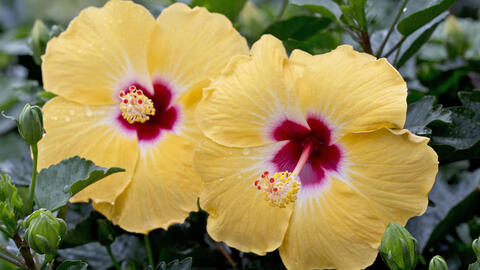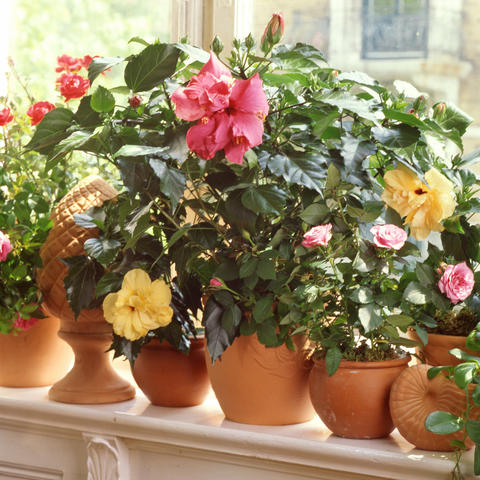How to care for Hibiscus: 5 tips for the perfect blossom
Hibiscus blooms vigorously and beautifully when well cared for. But the mallow family plant is challenging. These tips will have your mallow looking good all year round.

The flowers of Hibiscus rosa-sinensis ‘Curacao’ look like a summer cocktail
Chinese hibiscus (Hibiscus rosa-sinensis), also known as rose mallow, is one of the most popular houseplants and potted plants. With magnificent colors and elegant growth, rose mallow transforms any patio into an exotic oasis of flowers. Its large trumpet-shaped flowers can be admired in white, yellow, orange, pink and red with a wide variety of color gradients. The double-flowered breeds are particularly fascinating, but are slightly more sensitive than the simple varieties. Here are the most important hibiscus care tips at a glance.
The Chinese hibiscus is sensitive to the cold, therefore ordinary room temperatures are perfect. Hence, Hibiscus rosa-sinensis thrives indoors and in conservatories. A sunny window is the ideal spot for beautiful rose mallow. However, in midsummer, the full midday sun can be too much of a good thing. During summer, you can also maintain hibiscus outdoors in warm spots on balconies or patios. Rose mallow needs a spot that protects against rain in particular because the delicate flowers suffer in conditions that are too wet. Also outdoors, the Hibiscus should be in the brightest possible location but it shouldn't spend hours in the blazing sun.

Hibiscus is a demanding plant to care for, its soil should be consistently fresh and nutrient-rich. The substrate should be well-drained since hibiscus prefers slightly dry soil over wet soil. Mixing some sand into the soil is recommended as it improves drainage. The pH value can be either slightly acidic or slightly alkaline. Repotting is best in spring, when the old pot is completely rooted through. If you don’t wish the plant to get any bigger, you only need to replace the substrate and can return the Hibiscus to its old pot.
Get your rose mallow into shape by pruning it using shears in spring. Pruning Hibiscus regularly promotes branching and increases the abundance of flowers. Cut the previous year’s shoots back slightly and thin out the plant a little if needed. If you want to grow your Hibiscus as a standard tree, you need to cut off the young plant’s side branches so that only the main stem develops. Cut back the tip once it reaches the desired height. Tie the middle main shoot to a pole so that it serves as an extension of the trunk. The direct side shoots on the outside will become the stem’s new crown. Cut these branches back regularly for a densely branched plant. And after a few years you’ll have a beautiful, compact, spherical crown.
If the Hibiscus plant is over-mature and no longer blooming due to inadequate care, rejuvenation pruning can help to get it flowering again. Cut all the branches back to different heights (maximum 20 inches) and thin out the plant to make room for new growth. Note: After a hard rejuvenation prune, the plant will not initially flower. But it will be all the more energetic the following year.
You need a little bit of intuition when caring for Hibiscus, the plant soon gets upset if you neglect it and responds by dropping its leaves and flowers. Rose mallow gets very thirsty during the flowering stage. During this time it should be watered daily, but with care so that no waterlogging occurs. Make sure that you choose a pot that drains well. Excess water must be removed from planters and saucers. Hibiscus also reacts sensitively by dropping its flowers when it is too dry. During the growth period in spring your Hibiscus needs a weekly dose of liquid fertilizer because leaf and flower development require a lot of energy.
During the winter months, the indoor Hibiscus may stand a few degrees cooler than in summer, for example in the bedroom. Potted plants can be moved from the patio or balcony into winter quarters as soon as the outdoor thermometer drops below 54 degrees Fahrenheit. Check the plant for pests before taking it inside for winter and remove all dead leaves and branches. The plant can be lightly pruned if it is too big. Freshly groomed the rose mallow can now be kept in a cool (60 to 64 degrees Fahrenheit is ideal) but bright place, like a cool conservatory, until next summer. Note: A little leaf fall in winter quarters is normal. But if the Hibiscus plant is losing a lot of leaves it needs more light. The plant needs less water over the winter months. But do not allow the root ball to completely dry out. There is no need to fertilize the plant during its resting period.

Only Rose of Sharon (Hibiscus syriacus) or the rarer Swamp Rose Mallow (Hibiscus x moscheutos) are suitable for planting out in flower beds all year round. However, even these frost-resistant species should be given winter protection in the form of mulch and a covering fleece. Cold-hardy Hibiscus species in pots can stay outdoors over winter. Move the pot close to the walls of the house and protect the root ball from freezing with a warming cover.



